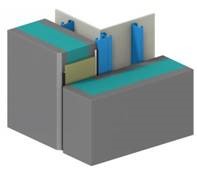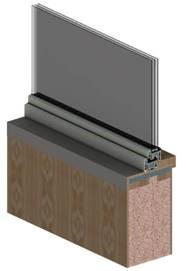
canadiancontractor
Five Principles of Passive House Design and Construction Part 4
Canadian Contractor"One of the most impactful thermal bridges on a project can be window-to-wall interfaces"
Passive House is considered the most rigorous voluntary energy-based standard in the design and construction industry today. Consuming up to 90 percent less heating and cooling energy than conventional buildings, Fundamental to the energy efficiency of these buildingsare the following five principles: 1) superinsulated envelopes, 2) airtight construction, 3) high-performance glazing, 4) thermal-bridge-free detailing, and 5) heat recovery ventilation. In this five-part series, Neil Norris, senior industry consultant for Passive House Canada outlines how the Passive House concept can inform conventional building.
Thermal-Bridge-Free Detailing
By Neil Norris
The last envelope consideration is the minimization of thermal bridging. This was discussed earlier for repeating thermal bridges in the general wall and roof assemblies, but Passive House designs also aim to be thermal-bridge-free when it comes to architectural interface details. These are parts of the building where different architectural features meet that require additional attention in construction. Examples include how a window is attached to the walls and how walls meet at corners.

Wall corner

Window sill transition
The way these building features connect and are designed can also introduce thermal bridging that is not always easy to recognize.
Thermal bridging from the interface details can have numerous effects on building performance. For highly insulated envelopes like those in Passive House projects thermal bridging can significantly reduce the benefits of superinsulating by allowing heat to flow around the insulating and out of the building, and can also create localized cold spots, increasing the risk of condensation and mold growth around these details.
The easiest way to avoid thermal bridging is by making architectural design changes (where possible), such as using self-supported decks and canopies for low-rise buildings or reducing the number of cantilevered balconies and articulating architecture (lots of corners) on larger buildings. This is not always realistic or achievable, and in these cases, special attention needs to be paid to these interfaces. Reducing direct conductive connections between the interior and exterior is important. Examples include intermittent connections for shelf angles, overinsulating in front of certain connections around the foundation, wrapping insulation around protruding details, or using special materials such as thermal breaks.
While it may not seem obvious, one of the most impactful thermal bridges on a project can be window-to-wall interfaces. The total perimeter of all the window-to-wall connections can add up to several kilometers on some projects, so how a window is installed into an opening is very important in minimizing the heat flow. Reducing thermal bridging at this connection involves positioning the window to line up with the insulation layer, overinsulating in front of the frame and minimizing how far closure flashings penetrate the rough opening while still maintaining adequate drainage paths.
Eliminating or minimizing thermal bridging on Passive House projects helps ensure the effectiveness of the envelope performance in reducing space-heating energy use.
Neil Norris is senior industry consultant, Passive House Canada
The 2019 Passive House Canada Conference takes place on October 17 & 18 at the University of Toronto Scarborough. The conference is a two-day deep dive into leading Passive House projects, best practices, and lessons learned. Program sessions will focus on Part 3 and 9 buildings, multi-unit residential buildings, retrofits, and hands-on skills seminars. Conference takes place on October 17 & 18 at the University of Toronto Scarborough. For more information or to register for the conference go to the Conference website.

Leave a Reply